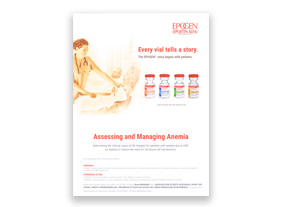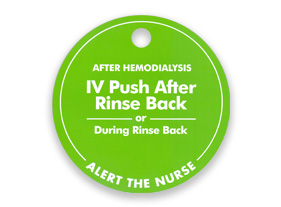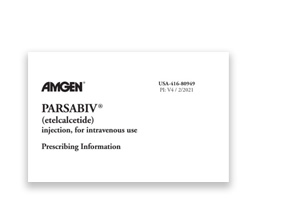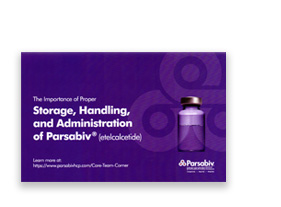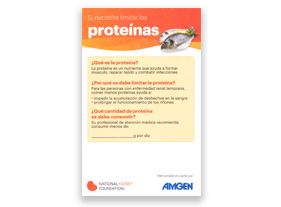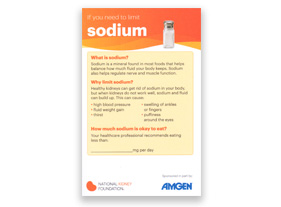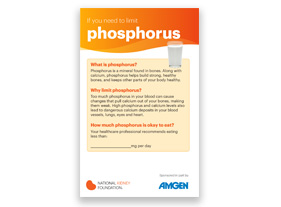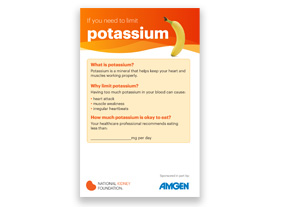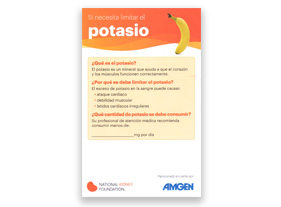Indication
ARANESP® (darbepoetin alfa) is indicated for the treatment of anemia due to chronic kidney disease (CKD), including patients on dialysis and patients not on dialysis. Read More
Indication
EPOGEN® (epoetin alfa) is indicated for the treatment of anemia due to chronic kidney disease (CKD) in patients on dialysis to decrease the need for red blood cell (RBC) transfusion. Read More
Indication and Limitations of Use:
Parsabiv® (etelcalcetide) is indicated for the treatment of secondary hyperparathyroidism (HPT) in adult patients with chronic kidney disease (CKD) on hemodialysis. Read More

Aranesp® Resources
HCP Materials


Aranesp Dosing Brochure

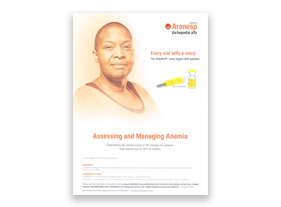
Aranesp Anemia Assessment and Management


Aranesp Commitment to Support Brochure

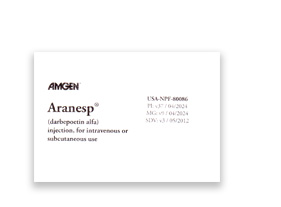
Aranesp Package Insert & Medication Guide

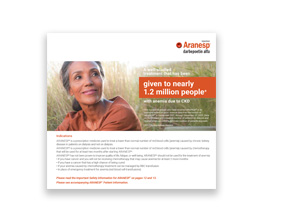
Aranesp Patient Education Brochure 2022


Aranesp Patient Brochure - Spanish
- In controlled trials, patients experienced greater risks for death, serious adverse cardiovascular reactions, and stroke when administered erythropoiesis-stimulating agents (ESAs) to target a hemoglobin level of greater than 11 g/dL.
- No trial has identified a hemoglobin target level, ARANESP® dose, or dosing strategy that does not increase these risks.
- Use the lowest ARANESP® dose sufficient to reduce the need for red blood cell (RBC) transfusions.
- ESAs shortened overall survival and/or increased the risk of tumor progression or recurrence in clinical studies of patients with breast, non-small cell lung, head and neck, lymphoid, and cervical cancers.
- To decrease these risks, as well as the risk of serious cardiovascular and thromboembolic reactions, use the lowest dose needed to avoid RBC transfusions.
- Use ESAs only for anemia from myelosuppressive chemotherapy.
- ESAs are not indicated for patients receiving myelosuppressive chemotherapy when the anticipated outcome is cure.
- Discontinue following the completion of a chemotherapy course.
-
ARANESP® is contraindicated in patients with:
— Uncontrolled hypertension— Pure red cell aplasia (PRCA) that begins after treatment with ARANESP® or other erythropoietin protein drugs— Serious allergic reactions to ARANESP®
- Use caution in patients with coexistent cardiovascular disease and stroke.
- Patients with CKD and an insufficient hemoglobin response to ESA therapy may be at even greater risk for cardiovascular reactions and mortality than other patients. A rate of hemoglobin rise of > 1 g/dL over 2 weeks may contribute to these risks.
- In controlled clinical trials, ESAs increased the risk of death in patients undergoing coronary artery bypass graft surgery (CABG) and the risk of deep venous thrombosis (DVT) in patients undergoing orthopedic procedures.
- Control hypertension prior to initiating and during treatment with ARANESP®.
- ARANESP® increases the risk of seizures in patients with CKD. Monitor patients closely for new-onset seizures, premonitory symptoms, or change in seizure frequency.
- For lack or loss of hemoglobin response to ARANESP®, initiate a search for causative factors. If typical causes of lack or loss of hemoglobin response are excluded, evaluate for PRCA.
-
Cases of PRCA and of severe anemia, with or without other cytopenias that arise following the development of neutralizing antibodies to erythropoietin have been reported in patients treated with ARANESP®.
— This has been reported predominantly in patients with CKD receiving ESAs by subcutaneous administration.— PRCA has also been reported in patients receiving ESAs for anemia related to hepatitis C treatment (an indication for which ARANESP® is not approved).— If severe anemia and low reticulocyte count develop during treatment with ARANESP®, withhold ARANESP® and evaluate patients for neutralizing antibodies to erythropoietin.— Permanently discontinue ARANESP® in patients who develop PRCA following treatment with ARANESP®, or other erythropoietin protein drugs. Do not switch patients to other ESAs.
- Serious allergic reactions, including anaphylactic reactions, angioedema, bronchospasm, skin rash, and urticaria may occur with ARANESP®.Immediately and permanently discontinue ARANESP® if a serious allergic reaction occurs.
- Blistering and skin exfoliation reactions including Erythema multiforme and Stevens-Johnson Syndrome (SJS)/Toxic Epidermal Necrolysis (TEN), have been reported in patients treated with ESAs (including ARANESP®) in the postmarketing setting. Discontinue ARANESP® therapy immediately if a severe cutaneous reaction, such as SJS/TEN, is suspected.
- Adverse reactions (≥ 10%) in ARANESP® clinical studies in patients with CKD were hypertension, dyspnea, peripheral edema, cough, and procedural hypotension.
- In controlled trials, patients experienced greater risks for death, serious adverse cardiovascular reactions, and stroke when administered erythropoiesis-stimulating agents (ESAs) to target a hemoglobin level of greater than 11 g/dL.
- No trial has identified a hemoglobin target level, ESA dose, or dosing strategy that does not increase these risks.
- Use the lowest EPOGEN® dose sufficient to reduce the need for red blood cell (RBC) transfusions.
- ESAs shortened overall survival and/or increased the risk of tumor progression or recurrence in clinical studies of patients with breast, non-small cell lung, head and neck, lymphoid, and cervical cancers.
- To decrease these risks, as well as the risk of serious cardiovascular and thromboembolic reactions, use the lowest dose needed to avoid RBC transfusions.
- Use ESAs only for anemia from myelosuppressive chemotherapy.
- ESAs are not indicated for patients receiving myelosuppressive chemotherapy when the anticipated outcome is cure.
- Discontinue following the completion of a chemotherapy course.
- Due to increased risk of Deep Venous Thrombosis (DVT), DVT prophylaxis is recommended.
-
EPOGEN® is contraindicated in patients with:
— Uncontrolled hypertension— Pure red cell aplasia (PRCA) that begins after treatment with EPOGEN® or other erythropoietin protein drugs— Serious allergic reactions to EPOGEN®
- EPOGEN® from multidose vials contains benzyl alcohol and is contraindicated in neonates, infants, pregnant women, and lactating women.
- Use caution in patients with coexistent cardiovascular disease and stroke.
- Patients with CKD and an insufficient hemoglobin response to ESA therapy may be at even greater risk for cardiovascular reactions and mortality than other patients. A rate of hemoglobin rise of > 1 g/dL over 2 weeks may contribute to these risks.
- In controlled clinical trials, ESAs increased the risk of death in patients undergoing coronary artery bypass graft surgery (CABG) and the risk of deep venous thrombosis (DVT) in patients undergoing orthopedic procedures.
- Control hypertension prior to initiating and during treatment with EPOGEN®.
- EPOGEN® increases the risk of seizures in patients with CKD. Monitor patients closely for new-onset seizures, premonitory symptoms, or change in seizure frequency.
- For lack or loss of hemoglobin response to EPOGEN®, initiate a search for causative factors. If typical causes of lack or loss of hemoglobin response are excluded, evaluate for PRCA.
-
Cases of PRCA and of severe anemia, with or without other cytopenias that arise following the development of neutralizing antibodies to erythropoietin have been reported in patients treated with EPOGEN®.
— This has been reported predominantly in patients with CKD receiving ESAs by subcutaneous administration.— PRCA has also been reported in patients receiving ESAs for anemia related to hepatitis C treatment (an indication for which EPOGEN® is not approved).— If severe anemia and low reticulocyte count develop during treatment with EPOGEN®, withhold EPOGEN® and evaluate patients for neutralizing antibodies to erythropoietin.— Permanently discontinue EPOGEN® in patients who develop PRCA following treatment with EPOGEN® or other erythropoietin protein drugs. Do not switch patients to other ESAs.
- Serious allergic reactions, including anaphylactic reactions, angioedema, bronchospasm, skin rash, and urticaria may occur with EPOGEN®. Immediately and permanently discontinue EPOGEN® if a serious allergic reaction occurs.
- Blistering and skin exfoliation reactions including Erythema multiforme and Stevens-Johnson Syndrome (SJS)/Toxic Epidermal Necrolysis (TEN), have been reported in patients treated with ESAs (including EPOGEN®) in the postmarketing setting. Discontinue EPOGEN® therapy immediately if a severe cutaneous reaction, such as SJS/TEN, is suspected.
- Serious and fatal reactions including "gasping syndrome" can occur in neonates and infants treated with benzyl alcohol-preserved drugs, including EPOGEN® multiple-dose vials. There is a potential for similar risks to fetuses and infants exposed to benzyl alcohol in utero or in breast-fed milk, respectively.
- Adverse reactions (≥ 5%) in EPOGEN® clinical studies in patients with CKD were hypertension, arthralgia, muscle spasm, pyrexia, dizziness, medical device malfunction, vascular occlusion, and upper respiratory tract infection.



